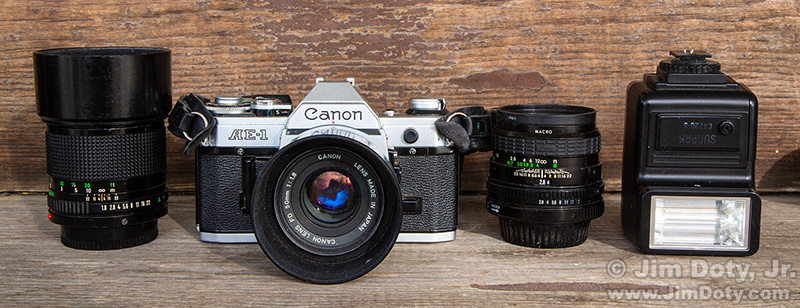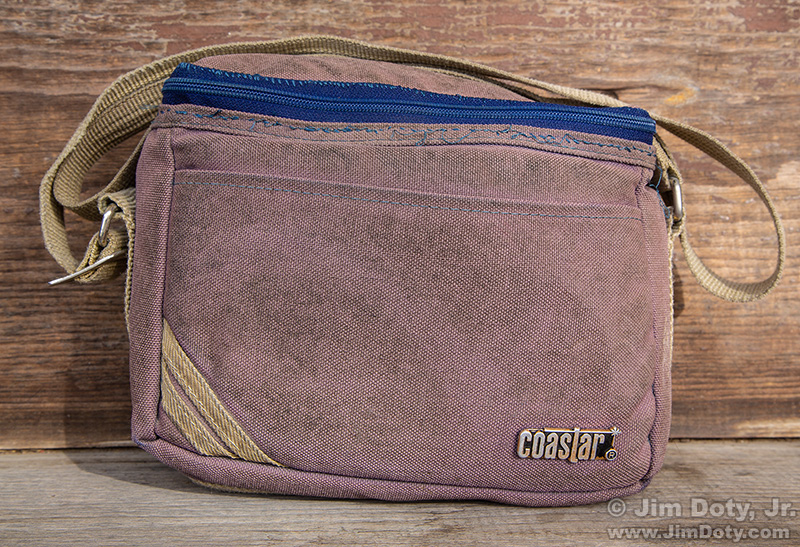
The first rule when choosing camera gear is to buy what you can afford. It is hard to enjoy taking pictures if you are worried about how to pay for the camera you are holding. So buy what you can afford now, and upgrade later. And the second rule? We will get to that later.
It really is possible to put together an economical camera kit, even if it takes a while to do it.
The camera kit pictured above was my basic, go everywhere kit from the mid 1980s into the 1990s. I acquired it a little bit at a time.
I bought the Canon AE-1 camera with the FD 50mm f/1.8 lens for $117 at a pawn shop. I was very excited about the price. The pawn shop had a TV set which I used to test the camera’s faster shutter speeds. Everything else I needed to test was simple to do. So I could buy the camera and lens with confidence. Today I would hesitate to buy a digital camera at a pawn shop. They are far more complex and harder to test than the manual camera’s of the 80s.
There were times the 50mm lens just wasn’t wide enough and I couldn’t back up far enough. I needed a wide angle lens. So my next purchase was the Sigma 28mm f/2.8 lens to the right of the camera. It was a pawn shop purchase too and cost $25. Another good find!
I don’t remember what I paid for the Sunpak flash, but it wasn’t much more than $15-$20. The camera did not have a built in flash so I finally had to break down and buy a flash.
The 50mm lens wasn’t long enough for some situations, so I needed a longer lens. I found the used Canon FD 85mm f/1.8 lens. It was about $80.
Over a couple years time I spent about $250 to put together my travel kit. It all fit in an inexpensive, 8 inches wide, 7 inches tall, 4 inches deep Coaster camera bag. A cable release fit in the front pocket. You can just about make out the slight, curving bulge of the cable release over the Coaster name. After several years of carrying this small bag nearly everywhere, the zipper began to rip off the bag. Why buy a new bag? I bought a new zipper and hand sewed it to the bag. I don’t sew very well so you can see my rather ugly stitch work.
I have a lot of happy memories and photos connected with this kit, which is why I still have it. I popped a battery in the camera today and it still works.
You can still find some great deals on photo gear today. You can buy a quality DSLR with two lenses and a built in flash for less than $400. This isn’t top of the line, of course, but it will do a good job. Compared to $250 over 30 years ago, that is pretty remarkable. And it is a better, more capable kit than the one I was using in the 80s and 90s.
My point is to buy what you can afford, make the most of it, and have fun using it. Most bad photos aren’t due to inexpensive equipment, they are due to poor photography skills.
That doesn’t mean equipment doesn’t matter. There is some poorly designed photography gear out there in a wide variety of prices.
Which brings us to the second rule. Don’t buy poorly designed, poor quality camera gear. There are almost always good quality options at the same price as the poor quality gear.
At one of our weekend photography workshops on Gibraltar Island (for Ohio State University), Jeremy Bruskotter and I were trying to help a student with a difficult to work with point and shoot camera. Some of the most basic camera functions were buried away, deep in a complex menu system. We didn’t tell the student, but the design of the camera was terrible. It took a long time to find what we were looking for. The manual for the camera did not even describe some of the most important menu choices, or where to find them in the menu system, so we had to work our way down through each menu option. What a pain. Worst of all, the camera cost over $1,000. I was thinking (to myself) about several point and shoot cameras in the $300 to $500 price range that were much better designed and would do what the student wanted to do without being hampered by such a poorly designed menu system. The student could have had a better camera at half the price or less.
So whatever camera budget you have to work with, your choices matter. So I recommend quality camera gear in all kinds of price ranges in my buyer’s guide series (link below) . My goal is to help photographers find the best equipment they can at a price they can afford. I do my best to help people avoid making expensive mistakes.
Series Link
This is one in a series of articles that will guide you to the best of all things photographic. The rest of the series is here: Buyer’s Guide: Recommendations For The Best Photography Equipment, Software, Books, Magazines, DVDs, Online Photo Labs and More.


